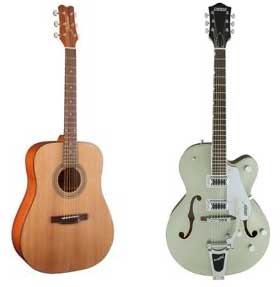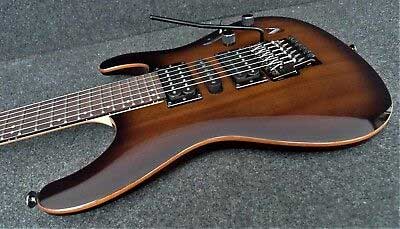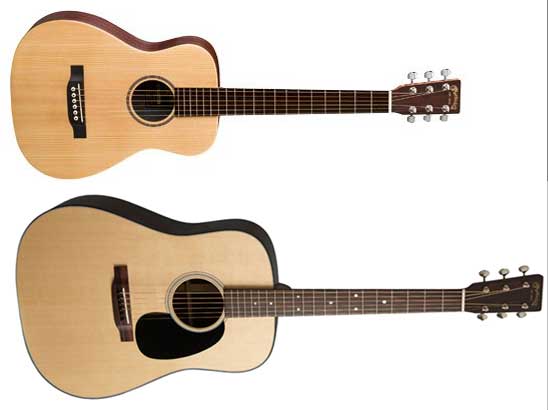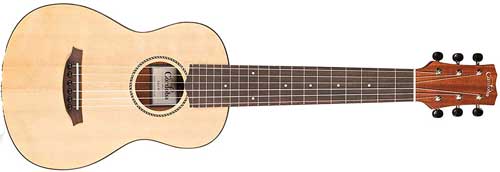If you have small hands or short fingers, choosing the right guitar is crucial to make sure it feels comfortable to play.
The best guitar for you is the one you stick with and are happy to play. When you have small hands, some guitars can feel awkward or even painful to play. This guide will help you find the best guitar to suit your small hands.
I’ll also explain the important aspect of playing guitar with small hands that I noticed is missing on similar articles on other websites.
In this guide, you will learn:
- The different types of guitars suitable for small hands
- How to deal with pain in your hands when you play guitar
- Guitar finger exercises suitable for small hands
- Tips and advice that have worked for my students with small hands
Finding the right type of guitar is only half of the picture, so in this guide, I’ll make sure you know what to do to get your guitar to feel as comfortable as possible.
Are Your Hands Too Small?
You might worry that your hands are too small to play guitar or that you’re not making any progress because of your hands. Let’s have a look at whether that’s true.
Maybe you’ve tried to play some chords but struggled to place your fingers in the right spots. It seems almost impossible to stretch your fingers into position. Or maybe you feel pain in your hands when you play and are worried that your small hands just aren’t up to it.
Over the years, I’ve had many students come to me worried that they won’t be able to play guitar because their hands are too small.
Here’s the good news:
Every student I’ve ever had over the years has experienced difficulty in the beginning regardless of the size of their hands.
While that doesn’t sound like good news at all, it is. It means that the problems you’re experiencing aren’t likely to be because your hands are too small. The problems are more likely because it’s hard to learn guitar in the beginning.
I’ve had adult men with hands bigger than mine complain that they just can’t stretch their fingers into place and that their hands hurt when they try.
Yet I’ve had 7-year-old students easily wrap their tiny hands around a full-sized guitar and play those same chords with ease (after proper training).

The real issue isn’t the size of your hands (although size matters to a point), the real issue is that guitar requires you to stretch your hands in unusual ways.
If you’re experiencing pain or find it awkward to reach while your playing, part of the problem is due to the size of your hands. But the main issue is training your hands to stretch properly.
In this guide, I’ll first look at how different guitars feel to play, but then I’ll turn attention to the real issue you need to deal with when you have small hands. I’ll show you exercises you can use to train your hands to stretch properly.
As you will learn in this guide, small hands are perfectly capable of playing guitar when you train them properly.
Full-sized Guitars and Small Hands
While you might think that reduced-size guitars are your only option, let’s take a closer look to see if that’s true.
Let’s look at full-sized guitars and what they’re like to play when you have small hands.
While many people might want to immediately skip this option, it’s worth looking at as you might find some full-sized guitars are comfortable to play – even with small hands or short fingers.
Despite what the name suggests, all full-sized guitars aren’t exactly the same size. There can be quite a big difference in size between different ‘full-sized’ guitars.
Some full-sized guitars will feel impossible to play when you have small hands, while others will feel surprisingly comfortable.
Here are a few full-sized guitars:

When comparing the above guitars when you have small hands, there are two important parts to consider:
- The body (highlighted in the blue box)
- The neck (highlighted in the red box)
Both of these parts play a huge role in how a guitar feels to play, so let’s look at each part in detail so you know what to look for in any guitar.
Guitar Neck with Small Hands
First, take a look at the length of the red highlighted boxes across the different guitars. You’ll notice there is a big difference in the length between the different guitars.
Not all necks have the same length. As I explain in detail in my Guide on Guitar Scale Length, there can be a massive difference in the length of the neck between different full-sized guitars.
Here is a comparison of some different full-sized guitar neck lengths:

These are all considered full-size, but you can see the big difference between each guitar. The Fender Jaguar or Gibson Les Paul is going to feel much easier to play than the Ibanez.
The length of the neck affects how close together the frets are. The longer the neck, the larger the gap between frets. This is why many people with small hands tend to prefer reduced-size guitars. The frets are closer together, so your hands don’t need to stretch as far.
But the length isn’t the most important point when looking at the neck. The most important point when you have small hands is the width and radius of the neck.
Some guitars have a thick and chunky neck, which makes it hard for small hands to wrap around. Imagine trying to wrap your hand around a baseball bat – that’s what some guitars will feel like when you have small hands.
Imagine trying to wrap your hand around this thick guitar neck:

The below image compares different necks:

Notice that some necks are thin while others are thick and round? Each will feel completely different to play and generally speaking, you’ll find it much easier to reach the fretboard on guitars with a thin neck.
A thin neck makes it easier for small hands to reach the strings and may feel more comfortable to play.
You may be able to play a full-sized guitar with ease if the neck is thin and not too wide. While a full-sized guitar with a chunky neck may feel impossible.
The best guitar for short fingers or small hands is one with a flat neck that makes it easier for your shorter fingers to reach around the neck.
Key point: don’t just look at the length of a guitar, take a closer look at the thickness and radius of the neck. That’s what you’re placing your hand on so that’s what matters the most.
Guitar Body with Small Hands
The size and shape of the body play an important role in how comfortable the guitar feels to play when you have small hands. This is an important point I noticed other websites forget to mention when talking about the best guitars for small hands.
For example, a big bulky acoustic guitar (the first two guitars shown above) can feel overwhelming for a small child or a short adult. A child trying to reach the neck (highlighted in red) may struggle with a full-sized acoustic guitar, but one of the electric guitars might feel perfectly comfortable.
Imagine a small child trying to wrap their hands around these guitars:

I’ve seen adults struggle to reach the strings with bulky guitars like these, so if you have small hands, you may find the bulky size of the guitar is the real issue.
Now imagine wrapping your hands around this guitar:

It may not come across well in the photo, but this guitar is ridiculously slim and hugs close to your body. The contours in guitars like this one allow you to get even closer to the strings.
You may find that a full-sized steel-string acoustic guitar feels impossible to play with your hands. But a full-sized electric guitar with a contoured body that sits nicely on your lap may feel perfectly fine.
In the below video, you can see a 9-year-old girl play a full-sized electric guitar with ease (she’s also a great guitarist!):
Notice how the shape of the body makes it easy for her to reach her short arms to where they need to go? Her small hands have no problem playing incredibly difficult parts.
She’s even able to easily lean over the guitar and see what both hands are doing. She wouldn’t be able to do that at all with a full-sized acoustic guitar.
Now if she was to try and play something on a full-sized acoustic guitar, the bulky body of the guitar would make it difficult for her to properly reach the strings and see what she’s doing.
Key lesson: don’t assume you need to buy a reduced-size guitar just because you have small hands. I’ve taught many students over the years with small hands (children and adults) and most of them were perfectly fine with a full-sized guitar when the shape of the body fit them.
Later in this guide, I’ll give you exercises that will allow you to play any guitar with better comfort.
If you’re a smaller person or buying a guitar for a child, have a read of my guide on How Much Electric Guitars Weigh as it is important to also think about how much a guitar weighs.
While the size and shape of a guitar is the most important factor to consider, the weight of many guitars can be an issue for some people.
Why You Should Consider a Full-Size Guitar
The advice I see on other websites is that if you have small hands, buy a reduced-size guitar. While you can definitely consider those guitars, let’s look at why I recommend a full-sized guitar and why it may be a better option for you.
A full-size guitar won’t suit everybody, but from my experience as a guitar teacher, I can say that it will suit most people with small hands.
Your Hands are Never Too Small (unless you’re looking for a guitar for a child under 6-years)
While it may feel impossible to you right now, your hands are perfectly capable of learning to play on a full-sized guitar.
The earlier video of the 9-year-old is one of the countless examples of small hands being able to perform complicated material on a full-size guitar.
If a 7-year-old’s hands are capable of playing an open chord (they are), your hands will be more than capable of doing the same with the proper training.
The important point to keep in mind is that your hands are fully capable of playing on a full-size guitar – even if it doesn’t feel possible right now. Your hands are never too small to play guitar and you don’t need a reduced-size guitar to play.
Some people may prefer a reduced-size guitar, but even those people are capable of playing a full-sized guitar with some proper training.
More choices
Once you train your hands to be able to play on a full-sized guitar, you can play on almost anything. You’ll be able to walk into a guitar store and choose from a countless range of guitars in different shapes and styles.
There will be some guitars that will feel too big for you (eg: full-sized dreadnought acoustic guitars), but once you train your fingers to feel comfortable on a full-sized neck, you’ll have the freedom to play almost anything.
The downside of playing on a reduced-size guitar is that you’ll always be limited to those guitars. Left-handed guitarists are often disappointed when a brand doesn’t make a left-handed version of a guitar they like the look of.
If you can only play reduced-size guitars, you’ll be disappointed all the time by all the guitars that don’t come in a reduced-size version.
Reduced-scale Guitars
If you skipped the above section or aren’t convinced that you’re capable of playing a full-sized guitar, you probably want to know about reduced-scale guitars.
As the name suggests, these guitars simply reduce the scale length so the neck becomes shorter:

A shorter neck means the frets are closer together and the body can also scale down to feel more comfortable on your lap.
It should be no surprise that the travel guitar shown above is going to feel easier to play than the full-sized dreadnought below it.
As explained above, most of the time when somebody complains that a guitar is too big for their hands, the real issue is usually the guitar’s body. Reduced-scale guitars feel better because of the smaller neck, but also because the body is smaller.
So if you pick up a 3/4 size guitar or a travel guitar and think it’s perfect for your small hands, the chances are it’s just the size of the body that makes it feel more comfortable.
A good way to test whether this is true for you or not is by trying a travel guitar with a full-scale neck:

The above guitar has a full-width guitar neck, but is shorter in scale and has a far smaller body than a normal acoustic guitar.
When people with small hands try to play something like the above guitar, they suddenly realize how much of a difference the body of the guitar makes.
These type of travel guitars are one of the best choices when you feel a full-sized guitar is too big. You get a more comfortable guitar body that lets you easily reach the strings while not needing to compromise on the width of the neck.
There are even travel guitars with full-scale necks and reduced body sizes like the below Traveler guitar:

While buying this type of guitar just because you have small hands is extreme, it does show how important body size is on a guitar. It should be clear how easily accessible the strings are when the body of the guitar has been mostly removed.
While I don’t think people with small hands need a guitar like this, it might be worth considering if you like playing an acoustic guitar but hate dealing with a bulky guitar body.
Check out my guide on Travel Guitars here for more options that may suit you.
The guide also talks about the limitations and pros/cons of buying reduced-size guitars. It’s important to understand the compromises in tone and quality before you commit to buying a reduced-size guitar.
How to Stretch Your Fingers for Guitar
Regardless of the size of your hands or the length of your fingers, you need to learn to stretch your fingers out in ways that feel unnatural. As I mentioned earlier, everybody first struggles to play basic chords when learning guitar – even people with large hands.
I’ve written a thorough lesson filled with guitar finger exercises here that gives you everything you need to get your fingers in shape.
If you have small hands, some of these exercises will feel extremely difficult. But practicing these exercises is how you can overcome any perceived limitations of your hands.
Practice these exercises for 10 minutes every day and you’ll find that what used to feel impossible suddenly feels achievable.
If you haven’t done these type of exercises before, then spend some time working on them before you decide you need a guitar to cater to your smaller hands. With a week or two of practicing these exercises, your hand will be able to stretch far further than they can right now.
Here is an example of a popular finger exercise designed to stretch your fingers out:

The idea behind the exercise is simple, but it does wonders for finger strength.
You place your first finger (index finger) on the fifth fret and play it. Then play the 6th fret with your second finger (middle) while continuing to hold the first finger down.
Then play the 7th fret with your third finger while continuing to hold the other two fingers down. Finally, play the 8th fret with your fourth finger and hold all four fingers in place. Then you move to the next string and repeat the pattern.
By the time you get to your fourth finger, you’ll feel your fingers really stretch. Depending on the size of your hands and how much practice you’ve put in, this will feel easy or extremely difficult.
The main point to remember is that I’ve never had a student who was unable to do this exercise due to their hands being too small.
Some students needed some time to work up to this level, but everybody (including some 7-year-olds with tiny hands) achieved it.
Dealing with pain in your hand
Unfortunately, it’s completely normal to feel pain in your hands when you first learn guitar. Your hands aren’t used to stretching out and pressing down on the strings, so it’s like trying a new exercise and feeling pain in your muscles.
Everybody experiences some pain or discomfort when they first try to learn chords or play notes on the guitar for the first time. Having small hands can increase the discomfort because you need to press down harder than somebody with larger and stronger hands.
Here are some tips to deal with discomfort or pain in your hands:
- Take regular breaks. Give your hand time to recover after each practice session. Your hand is using muscles you normally don’t use, so they will get tired.
- Keep working with finger exercises. The exercises will quickly develop strength and control in your fingers. The sooner you develop this strength, the sooner the pain will stop.
- Use a lighter touch. Beginners always press down on the strings far harder than advanced guitarists. It might feel like you need to press down really hard, but you’ll soon learn that a lighter touch is possible. The pain will magically disappear when you develop a lighter touch.
- Use a capo. Place a capo on the neck and you’ll find that it reduces the amount of pressure you need to apply on the strings. Using a capo can help you get past the ‘growing pains’ stage of learning guitar.
The key point to remember is that everybody feels some discomfort in the beginning, and that discomfort will stop. Pace yourself and don’t give up – you’ll get through it.
If you’ve been learning on a full-sized guitar and looked up this article to find a smaller guitar to switch to, I highly recommend you spend some time with these exercises before you give up your existing guitar.
Unless it’s the size of the guitar’s body causing issues or a chunky neck making it hard to reach the strings, exercises like this one will significantly improve your hand’s ability to stretch out and play what you want.
If you want to switch to a smaller guitar to make things easier for you, that’s perfectly fine. But hopefully, this guide has explained why you shouldn’t think of small hands as a limitation when it comes to playing guitar.
